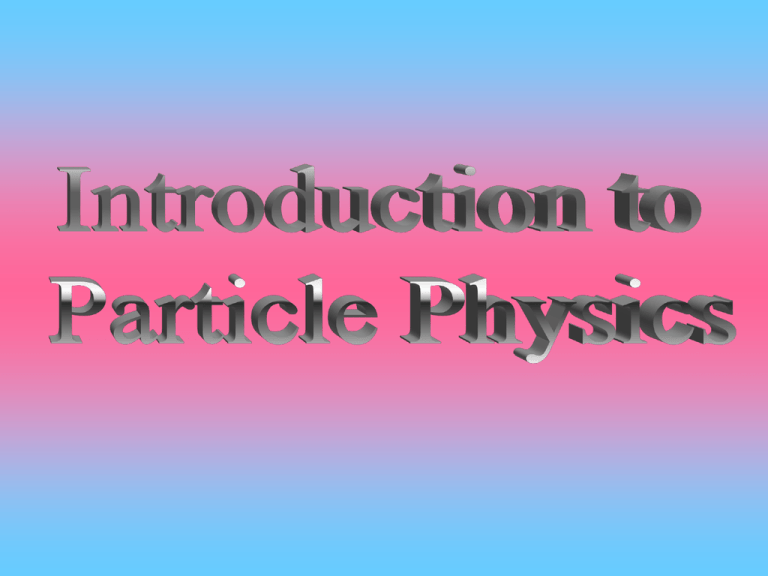Introduction to Particle Physics
advertisement

What are the Elementary Constituents of Matter? What are the forces that control their behaviour at the most basic level? History of Constituents of Matter AD •In Nuclear Reactions momentum and massenergy is conserved – for a closed system the total momentum and energy of the particles present after the reaction is equal to the total momentum and energy of the particles before the reaction •In the case where an alpha particle is released from an unstable nucleus the momentum of the alpha particle and the new nucleus is the same as the momentum of the original unstable nucleus Wolfgang Pauli 1 1 0 __ 0 n0 p1e 1 0 •Large variations in the emission velocities of the particle seemed to indicate that both energy and momentum were not conserved. •This led to the proposal by Wolfgang Pauli of another particle, the neutrino, being emitted in decay to carry away the missing mass and momentum. •The neutrino (little neutral one) was discovered in 1956. 1 1 0 __ 0 n0 p1e 1 0 1.008665 u 1.007825 u 0.0005486 u 1u= 1.660 10 27 kg 1J= 1.6 10 19 eV Mass difference 1.008665 (1.007825 0.0005486 ) 0.0002914 u 0.0002914 1.660 10 27 4.83724 10 31 kg kg E mc 2 (4.837241031)(3.0 108 ) 2J 4.353516 10 14 J 4.353516 10 14 1.602 10 19 271755eV 0.272 MeV It has been found by experiment that the emitted beta particle has less energy than 0.272 MeV Neutrino accounts for the ‘missing’ energy + + Cockroft and Walton •First artificial splitting of nucleus •First transmutation using artificially accelerated particles •First experimental verification 2 of E = mc Irish Nobel Prize E.T.S. Walton 1951 John Cockcroft Ernest Walton Experimental verification of 1 7 4 1H 3 Li 2 He 1 MeV Proton + Lithium 4 2 He E = 2 mc Energy 17.3 MeV Two alpha particles + Energy • Ancient Greeks: Earth, Air, Fire, Water • By 1900, nearly 100 elements • By 1936, back to three particles: proton, neutron, electron CERN LEP APPLET http://www.hep.ucl.ac.uk/masterclass/Acc_sim2/simulator.html The Four Fundamental Forces 20 Forces Electromagnetic Weak Strong Gravity atoms molecules optics electronics telecom. beta decay solar fusion particles inverse square law short range short range inverse square law photon W , Z0 ± gluon graviton Institute of Physics Peter Kalmus nuclei falling objects planet orbits stars galaxies Particles and the Universe m E c 2 Particle zoo 11 Feel weak force “predicted” later discovered Neutrinos 100,000,000,000,000 per second pass through each person from the Sun Antiparticles Equal and opposite properties “predicted” later discovered Annihilate with normal particles Now used in PET scans 1950s, 1960s Many new particles created in high energy collisions Convert energy to mass. Einstein E = mc2 > 200 new “elementary” (?) particles Institute of Physics Peter Kalmus Particles and the Universe Thomson (1897): Discovers electron 1x10 10 m 1x10 15 m 0.7 x10 15 m 0.7 x10 18 m _ 60 60 0 0 27 Co28 Ni 1e 0 Q = -1e almost all trapped in atoms Q= 0 all freely moving through universe Just as the equation x2=4 can have two possible solutions (x=2 OR x=-2), so Dirac's equation could have two solutions, one for an electron with positive energy, and one for an electron with negative energy. Dirac interpreted this to mean that for every particle that exists there is a corresponding antiparticle, exactly matching the particle but with opposite charge. For the electron, for instance, there should be an "antielectron" called the positron identical in every way but with a positive electric charge. e e 1928 Dirac predicted existence of antimatter 1932 antielectrons (positrons) found in conversion of energy into matter 1995 antihydrogen consisting of antiprotons and positrons produced at CERN In principle an antiworld can be built from antimatter Produced only in accelerators and in cosmic rays rays e e e e 2hf Q 2 3 Q 1 3 Q 1 Q0 James Joyce Murray Gell-Mann 1 3 1 3 1 3 2 3 2 3 2 3 12 Today’s building blocks Leptons Quarks (do not feel strong force) (feel strong force) electron e-neutrino 4 particles ee -1 up 0 down very simple multiply by 3 (generations) multiply by 2 (antiparticles) u d 2 2 1 1 3 3 3 proton = u u d 2 3 +2/3 1 -1/3 3 2 +2/3 1 1 = +1 +2/3 -1/3 0 3 3 3 neutron = u d d +2/3 -1/3 -1/3 = 0 First generation http://lectureonline.cl.msu.edu/~mmp/applist/q/q.htm




